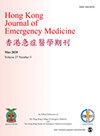静脉与动脉二氧化碳对动静脉含氧量比值的变化在严重败血症和感染性休克预后中的作用:一项系统综述和荟萃分析
IF 0.8
4区 医学
Q4 EMERGENCY MEDICINE
引用次数: 5
摘要
背景:脓毒症患者的组织灌注不足和缺氧应立即识别和复苏。最近,静脉与动脉的二氧化碳压力变化和动静脉含氧量差异比(Pcv-aCO2/Ca-vO2)作为组织灌注恢复和不良预后的预测指标。目的:Pcv-aCO2/Ca-vO2是呼吸熵的替代品,呼吸熵的升高表明缺乏组织灌注。Pcv-aCO2/Ca-vO2可作为预测败血症或感染性休克患者预后的指标,但其预后价值尚未得到充分评估。在这里,我们进行了一项荟萃分析,以评估其对死亡率的预测价值。方法:本荟萃分析遵循流行病学组指南中观察性研究的荟萃分析。我们搜索了PubMed、EMBASE、Web of Science和Cochrane图书馆从成立到2019年3月的综合电子数据库,使用的术语包括“静脉-动脉”、“二氧化碳”、“休克、败血症”和相关关键词。纽卡斯尔-渥太华量表用于文献的质量评估。使用RevMan 5.3和Stata 14.0软件进行了一项荟萃分析,以评估Pcv-aCO2/Ca-vO2对败血症或感染性休克患者的短期死亡率、连续器官衰竭评估以及急性生理学和慢性健康评估评分的影响。结果:最终分析包括13项临床研究,共涉及940名受试者。荟萃分析结果显示,液体复苏后,未存活患者的Pcv-aCO2/Ca-vO2高于存活患者(标准化平均差异 = 0.68,95%置信区间 = 0.24–1.12)和血样6 复苏后h的死亡率更高(风险比 = 1.89,95%置信区间 = 1.48–2.41)和顺序器官衰竭评估分数(平均差 = 1.58,95%置信区间 = 0.88–2.28,P < 0.01)。这些差异具有统计学意义。结论:该荟萃分析表明Pcv-aCO2/Ca-vO2对败血症或感染性休克患者的死亡率具有预测价值。现在需要进一步的研究来确定预测败血症死亡率的最佳阈值。Prospero注册:该系统审查的方案已在Prospero上注册(CRD 42019128134)。本文章由计算机程序翻译,如有差异,请以英文原文为准。
Utility of venous-to-arterial carbon dioxide changes to arteriovenous oxygen content ratios in the prognosis of severe sepsis and septic shock: A systematic review and meta-analysis
Background: Sepsis patients with insufficient tissue perfusion and hypoxia should be identified and resuscitated immediately. Recently, venous-to-arterial carbon dioxide pressure changes and the arteriovenous oxygen content difference ratio (Pcv-aCO2/Ca-vO2) as a predictor of tissue perfusion recovery and poor prognosis. Objectives: Pcv-aCO2/Ca-vO2 is a substitute for respiratory entropy, the elevation of which indicates a lack of tissue perfusion. Pcv-aCO2/Ca-vO2 can be used as an indicator to predict the prognosis of patients with sepsis or septic shock, but its prognostic value has not been fully evaluated. Here, we have performed a meta-analysis to assess its predictive value for mortality. Methods: Meta-analysis of Observational Studies in Epidemiology group guidelines were followed for this meta-analysis. We searched the comprehensive electronic databases of PubMed, EMBASE, Web of Science, and Cochrane libraries from inception to March 2019, using the terms including “venous-arterial,” “carbon dioxide,” “Shock, Septic,” and related keywords. The Newcastle-Ottawa scale was used for quality evaluation of the literature. A meta-analysis was performed using RevMan 5.3 and Stata 14.0 software to evaluate the effects of Pcv-aCO2/Ca-vO2 on short-term mortality, sequential organ failure assessment, and acute physiology and chronic health evaluation scores in patients with sepsis or septic shock. Results: The final analysis included 13 clinical studies involving a total of 940 subjects. The results of the meta-analysis showed that non-surviving patients had higher Pcv-aCO2/Ca-vO2 than survivors after fluid resuscitation (standardized mean difference = 0.68, 95% confidence interval = 0.24–1.12) and blood samples taken 6 h after resuscitation showed a greater risk of mortality (risk ratio = 1.89, 95% confidence interval = 1.48–2.41) and sequential organ failure assessment scores (mean difference = 1.58, 95% confidence interval = 0.88–2.28, P < 0.01) in patients with high Pcv-aCO2/Ca-vO2. These differences were statistically significant. Conclusion: This meta-analysis indicates that Pcv-aCO2/Ca-vO2 has predictive value for mortality in patients with sepsis or septic shock. Further studies are now required to determine the optimal threshold for predicting sepsis mortality. Prospero Registration: The protocol for this systematic review was registered on PROSPERO (CRD 42019128134).
求助全文
通过发布文献求助,成功后即可免费获取论文全文。
去求助
来源期刊

Hong Kong Journal of Emergency Medicine
EMERGENCY MEDICINE-
CiteScore
1.50
自引率
16.70%
发文量
26
审稿时长
6-12 weeks
期刊介绍:
The Hong Kong Journal of Emergency Medicine is a peer-reviewed, open access journal which focusses on all aspects of clinical practice and emergency medicine research in the hospital and pre-hospital setting.
 求助内容:
求助内容: 应助结果提醒方式:
应助结果提醒方式:


